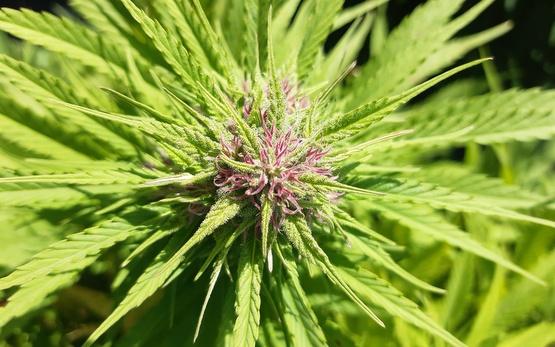Hemp (Cannabis sativa L.) was used as early as several millennia ago in Central Asia for fibre production. Its special characteristics make it suitable for a wide range of purposes. The plant is cultivated for the industrial use of its fibres, and for human nutrition in the case of the oil derived from its seeds. For a number of years now, so-called ‘CBD hemp’ has increasingly been grown. Here, the flowers of the plant are used to produce cannabidiol (CBD), a phytocannabinoid accounting for up to 40% of the plant’s extract.
CBD hemp is characterised by a low THC (Δ9-tetrahydrocannabinol) content lying below the limit of 1% THC. In Switzerland, plants and their products that lie above this limit are classified as narcotic substances (see classification in the FOAG’s Categories of use). Moreover, since 1 January 2021, hemp is no longer subject to agricultural seed legislation in Switzerland. Consequently, seeds and planting material can be produced and traded for commercial use in agriculture without the official registration of a hemp variety in the Variety Catalogue and the associated VCU test. CBD hemp varieties are often propagated vegetatively – the planting material must meet general phytosanitary requirements, and must only be marketed for commercial purposes with a plant passport. It should be stressed that use of variety protection rights can continue to be made, since the latter are subject to private law and enable the multiplication of the variety to be restricted and royalties to be claimed, irrespective of use.
With regard to the non-medical («recreational») use of narcotics with the same type of effect as cannabis (hemp with a THC content above 1%), an amendment was made to the Narcotics Act (NarcA) on 15 May 2021. In future, so-called pilot trials in which a controlled dose of cannabis may be dispensed to certain groups of people for non-medical («recreational») purposes can be authorised for research purposes by the Federal Office of Public Health.
There has been little research conducted into the use of the cannabinoids extracted from the plant. Cultivation techniques and the crop management of hemp plantations for use of the flowers have been similarly neglected. The latest legislative amendments regarding hemp pose additional new challenges for applied agricultural research. Nevertheless, interest in hemp as a field crop has grown substantially. The area devoted to field hemp cultivation in Switzerland has been growing steadily since 2015, and in 2020 stood at 291 ha (written communication from the Swiss Federal Statistical Office).
The aim of the projects is to find answers to questions concerning hemp cultivation technique and hemp variety testing.
Small-plot trials
In 2018, after a fairly long hiatus, small-plot trials with several varieties of hemp were once again conducted at Agroscope to investigate the suitability of these varieties for use as fibres and seed. The trials were expanded in 2019 to deal with questions regarding the use of the flowers. Since 2020, the variety trials have focused on characterising the agronomic and qualitative properties for flower use or cannabinoid extraction.







